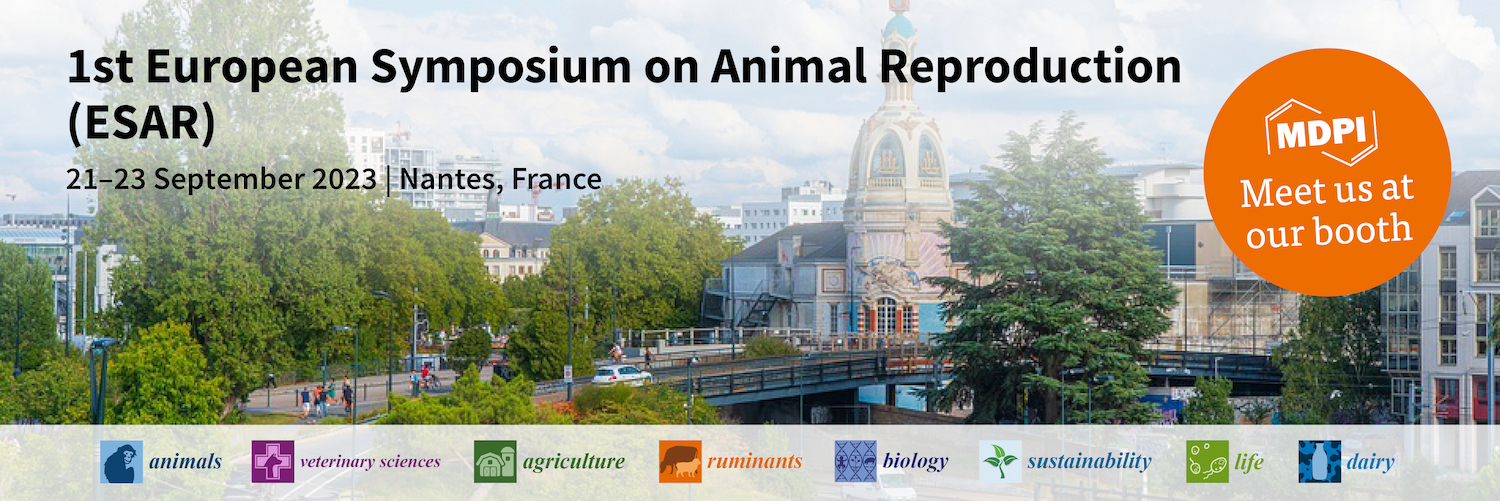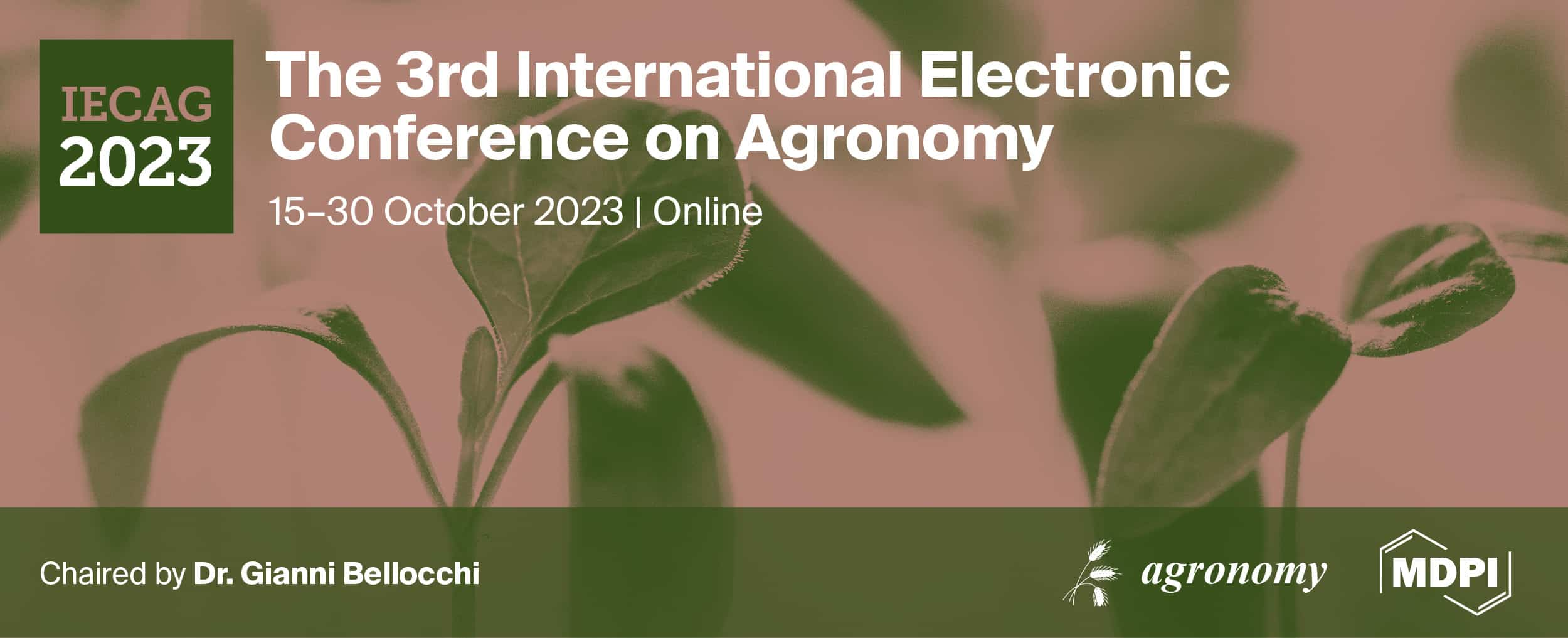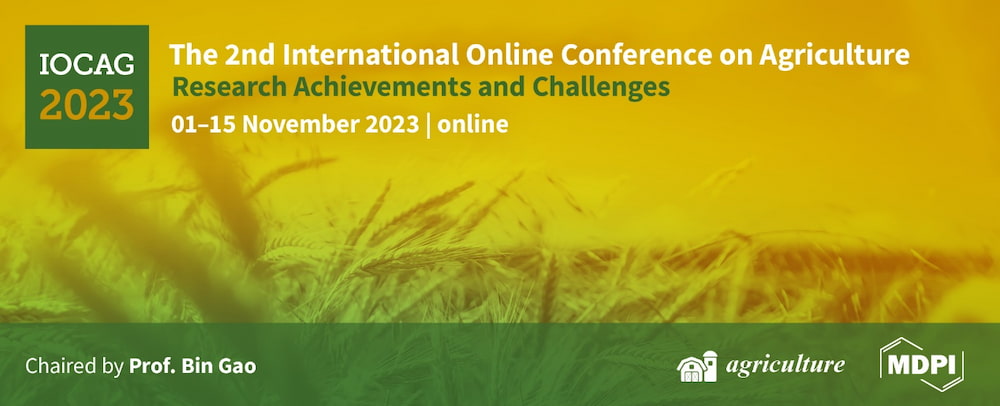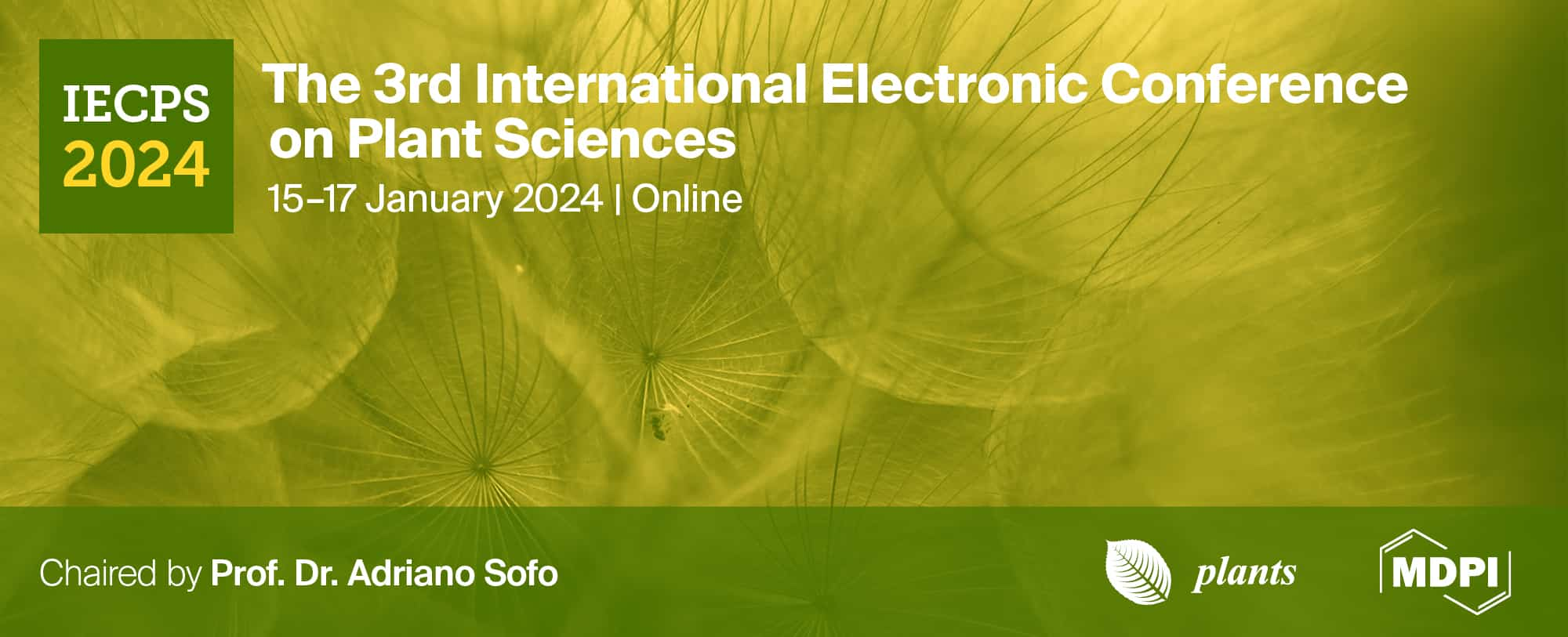-
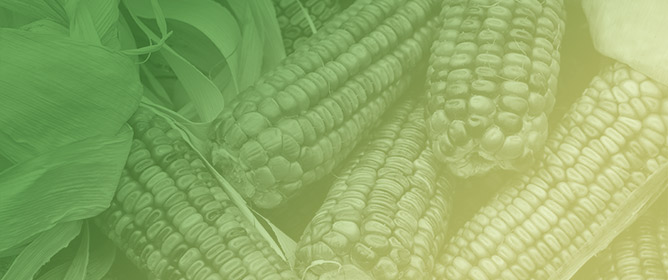 Estimation of Productivity and Above-Ground Biomass for Corn (Zea mays) via Vegetation Indices in Madeira Island
Estimation of Productivity and Above-Ground Biomass for Corn (Zea mays) via Vegetation Indices in Madeira Island -
 YOLO-Sp: A Novel Transformer-Based Deep Learning Model for Achnatherum splendens Detection
YOLO-Sp: A Novel Transformer-Based Deep Learning Model for Achnatherum splendens Detection -
 Agricultural Greenhouses: Resource Management Technologies and Perspectives for Zero Greenhouse Gas Emissions
Agricultural Greenhouses: Resource Management Technologies and Perspectives for Zero Greenhouse Gas Emissions -
 Deep Learning Models for the Classification of Crops in Aerial Imagery: A Review
Deep Learning Models for the Classification of Crops in Aerial Imagery: A Review -
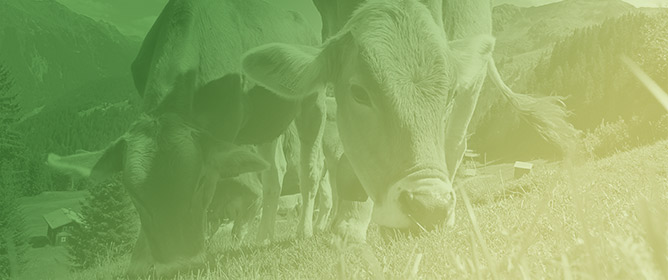 Environmental and Economic Responses to Precision Feed Management in Dairy Cattle Diets
Environmental and Economic Responses to Precision Feed Management in Dairy Cattle Diets
Journal Description
Agriculture
Agriculture
is an international, scientific peer-reviewed open access journal published monthly online by MDPI.
- Open Access— free for readers, with article processing charges (APC) paid by authors or their institutions.
- High Visibility: indexed within Scopus, SCIE (Web of Science), PubAg, AGRIS, RePEc, and other databases.
- Journal Rank: JCR - Q1 (Agronomy) / CiteScore - Q2 (Plant Science)
- Rapid Publication: manuscripts are peer-reviewed and a first decision is provided to authors approximately 16.6 days after submission; acceptance to publication is undertaken in 2.5 days (median values for papers published in this journal in the first half of 2023).
- Recognition of Reviewers: reviewers who provide timely, thorough peer-review reports receive vouchers entitling them to a discount on the APC of their next publication in any MDPI journal, in appreciation of the work done.
- Companion journals for Agriculture include: Poultry, Grasses and Crops.
Impact Factor:
3.6 (2022);
5-Year Impact Factor:
3.6 (2022)
Latest Articles
The Results of Experimental Studies of the Physical and Mechanical Properties of an Elastic-Plastic Material for Tribological Properties during Separation
Agriculture 2023, 13(9), 1735; https://doi.org/10.3390/agriculture13091735 (registering DOI) - 01 Sep 2023
Abstract
The obtained results of experimental studies on the influence of the physical and mechanical properties of an elastoplastic material (clods of soil and potato tubers) on the factors of its destruction when interacting with an absolutely solid body (separating working body) established that
[...] Read more.
The obtained results of experimental studies on the influence of the physical and mechanical properties of an elastoplastic material (clods of soil and potato tubers) on the factors of its destruction when interacting with an absolutely solid body (separating working body) established that an increase in the density of a soil clod leads to an increase in the effort expended on dynamic destruction, regardless of the size fraction. Within one fractional group, the increase in force from the minimum value necessary for the destruction of the soil clod in the density range from 1300 to 1700 kg/m3 is on average 56–67 N. However, there is a tendency to increase the effort to destroy the soil clod with an increase in the size fraction, including identical density, by 7–8 N, which is 4–5% of the initial value of the destruction force of a given density. The greatest destruction of soil clods is provided at a moisture content of 22–24%, which should be explained by the formation of the physical ripeness of the leached chernozem. In addition, a decrease in soil moisture leads to a more intense adhesion of soil particles to each other and, consequently, to an increase in the force on the soil clod to destroy it.
Full article
(This article belongs to the Special Issue Agricultural Machinery Design and Agricultural Engineering)
►
Show Figures
Open AccessArticle
Classification of Urban Agricultural Functional Regions and Their Carbon Effects at the County Level in the Pearl River Delta, China
Agriculture 2023, 13(9), 1734; https://doi.org/10.3390/agriculture13091734 (registering DOI) - 01 Sep 2023
Abstract
Exploring the transformation process of urban agricultural functions and its interaction with carbon effects based on regional differences is of great positive significance for achieving a low-carbon sustainable development of agriculture in metropolitan areas. By using the index system method, self-organizing feature maps
[...] Read more.
Exploring the transformation process of urban agricultural functions and its interaction with carbon effects based on regional differences is of great positive significance for achieving a low-carbon sustainable development of agriculture in metropolitan areas. By using the index system method, self-organizing feature maps (SOFM) network modeling, and Granger causality analysis, we divided the agricultural regional types of the Pearl River Delta (PRD) based on the spatio-temporal changes in urban agricultural functions and carbon effects at the county level in the PRD from 2002 to 2020, and analyzed the carbon effects generated by the agricultural functions according to the differences between the three agricultural regional types. The results show the following: (1) The changes in the basic functions of agriculture, the intermediate functions of agriculture, and the advanced functions of agriculture were different from the perspectives of both time and space. (2) The carbon effects produced by the areas with weak agricultural functions, the areas with medium agricultural functions, and the areas with strong agricultural functions were different. (3) The evolution of agricultural production types aggravated the grain risk in the PRD, and urban agriculture has potential in improving food security. (4) Based on the regional types of agricultural functions and considering the constraints of land and water, strategic suggestions such as integrating natural resources, improving utilization efficiency, upgrading technical facilities, and avoiding production pollution are put forward. (5) The green and low-carbon transformation of urban agriculture has its boundaries. The positive effects of the factors, namely the innovation of agricultural production methods, the change in agricultural organization modes, the impact of market orientation, and the transfer of the agricultural labor force, is limited. The findings of this paper provide valuable and meaningful insights for academia, policy makers, producers, and ultimately for the local population in general, driving the development of urban agriculture in a low-carbon and sustainable direction.
Full article
(This article belongs to the Topic Low Carbon Economy and Sustainable Development)
►▼
Show Figures
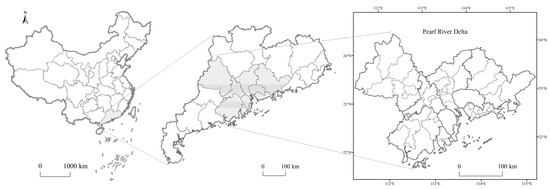
Figure 1
Open AccessArticle
Microplastic Pollution in EU Farmland Soils: Preliminary Findings from Agricultural Soils (Southwestern Poland)
Agriculture 2023, 13(9), 1733; https://doi.org/10.3390/agriculture13091733 (registering DOI) - 01 Sep 2023
Abstract
Agricultural soils are considered as “hot-spots” of plastic particles; however, due to a lack of standardized method of microplastic determination in soils, as well as no legal regulations requiring the monitoring of the soil environment in the context of microplastic contamination, the data
[...] Read more.
Agricultural soils are considered as “hot-spots” of plastic particles; however, due to a lack of standardized method of microplastic determination in soils, as well as no legal regulations requiring the monitoring of the soil environment in the context of microplastic contamination, the data on MP abundance and occurrence in European soils are very limited. In this first study of MPs pollution in agricultural soils in Poland, we developed a method of microplastic extraction from soil samples with different properties (particle size distribution, clay and organic matter content) and used optical microscopy for MP determination and quantification. In this study, we analyzed 44 soil samples from five sampling site locations with differing soil type, agricultural activity, including farmland soils on floodplains and past records of sewage sludge and compost applications. We found evidence that 93% of cultivated soils in the SW part of Poland contained MPs. The content of MP varied between soil types and present/former use of the land. Loamy and clay soils contained more MPs, 1540 ± 912 particles per kg soil and 933 ± 682 particles per kg, respectively, compared with sandy soils at 383 ± 188 particles per kg of soil. The highest MP concentrations were determined in soils amended with sewage sludge, wastewaters and green-waste composts (up to 4050 ± 2831 particles per kg of soil). The wide distribution of MPs with a dominance of plastic fibers (up to 60% of determined MP types) can be associated with agricultural sources such as soil mulching, the use of organic fertilizers, seed coating or unintentional waste dumping and air deposition.
Full article
(This article belongs to the Special Issue Emerging Contaminants in Soil Systems: Occurrence, Fate, Behavior and Impact)
►▼
Show Figures

Figure 1
Open AccessArticle
Prediction of Tea Varieties’ “Suitable for People” Relationship: Based on the InteractE-SE+GCN Model
Agriculture 2023, 13(9), 1732; https://doi.org/10.3390/agriculture13091732 (registering DOI) - 31 Aug 2023
Abstract
This study proposes an improved link prediction model for predicting the “suitable for people” relationship within the knowledge graph of tea. The relationships between various types of tea and suitable target groups have yet to be fully explored, and the existing InteractE model
[...] Read more.
This study proposes an improved link prediction model for predicting the “suitable for people” relationship within the knowledge graph of tea. The relationships between various types of tea and suitable target groups have yet to be fully explored, and the existing InteractE model still does not adequately capture a portion of the complex information around the interactions between entities and relationships. In this study, we integrate SENet into the feature layer of the InteractE model to enhance the capturing of helpful information in the feature channels. Additionally, the GCN layer is employed as the encoder, and the SENet-integrated InteractE model is used as the decoder to further capture the neighbour node information in the knowledge graph. Furthermore, our proposed improved model demonstrates significant improvements compared to several standard models, including the original model from public datasets (WN18RR, Kinship). Finally, we construct a tea dataset comprising 6698 records, including 330 types of tea and 29 relationship types. We predict the “suitable for people” relationship in the tea dataset through transfer learning. When comparing our model with the original model, we observed an improvement of 1.4% in H@10 for the WN18RR dataset, a 7.6% improvement in H@1 for the Kinship dataset, and a 5.2% improvement in MRR. Regarding the tea dataset, we achieved a 4.1% increase in H@3 and a 2.5% increase in H@10. This study will help to fully exploit the value potential of tea varieties and provide a reference for studies assessing healthy tea drinking.
Full article
(This article belongs to the Topic Applications of Big Data and Machine Learning in Smart Agriculture)
Open AccessArticle
Response of Quality and Yield of Foxtail Millet to Nitrogen and Zinc Application
by
, , , , , , , and
Agriculture 2023, 13(9), 1731; https://doi.org/10.3390/agriculture13091731 (registering DOI) - 31 Aug 2023
Abstract
The effect of nitrogen and zinc treatment on quality and yield was studied to provide a theoretical basis for generating high-quality and high-yielding foxtail millet. In the years 2021–2022, ‘Jingu 21’ was utilized as the test material in a split-plot design. The main
[...] Read more.
The effect of nitrogen and zinc treatment on quality and yield was studied to provide a theoretical basis for generating high-quality and high-yielding foxtail millet. In the years 2021–2022, ‘Jingu 21’ was utilized as the test material in a split-plot design. The main plot was subjected to nitrogen treatment, while the sub-plot was treated with zinc. An arrangement of random blocks was employed. Four levels of nitrogen application (0 kg/hm2, 120 kg/hm2, 180 kg/hm2, 240 kg/hm2) and three levels of zinc application (20 mg/L, 40 mg/L, 80 mg/L foliar spraying) were set, resulting in a total of twelve treatments. Each treatment was replicated three times, with each plot covering an area of 15 m2. (1) The findings indicated that the contents of crude fat and crude protein in foxtail millet increased initially and then decreased with the increase in nitrogen application concentration. Additionally, the protein components were found to be in the following order: gliadin > albumin > glutenin > globulin. (2) Adding an appropriate amount of nitrogen fertilizer under the same zinc level promoted the contents of amylose, total carotenoids, and flavonoids in millet to some extent. Over the course of two years, the content of flavonoids in millet was highest when treated with N180Zn40 (nitrogen 180 kg/hm2, zinc 40 mg/L), showing an increase of 50.14% and 58.67%, respectively, compared to the treatment of applying zinc fertilizer alone at the same zinc level. (3) The phytic acid content and phytic acid/zinc molar ratio exhibited a pattern of initially decreasing and then increasing with the rise in nitrogen and zinc concentrations. (4) The application of zinc fertilizer and increased nitrogen fertilizer for two consecutive years had a significant impact on the yield of millet. Additionally, the application of zinc fertilizer had a highly significant effect on both the ear weights and thousand-kernel weights of millet (p < 0.001). The results demonstrated a positive synergistic effect when nitrogen fertilizer and zinc fertilizer were applied together. This combination significantly improved millet yield and thousand-kernel weights, enhanced the nutritional quality, and increased the content of functional components. Additionally, it also improved the availability of zinc.
Full article
(This article belongs to the Section Crop Production)
►▼
Show Figures
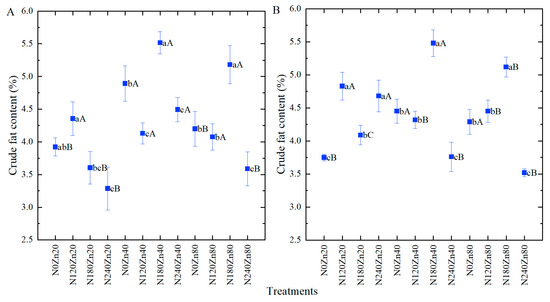
Figure 1
Open AccessArticle
Spatial Distribution Heterogeneity and Influencing Factors of Different Leisure Agriculture Types in the City
Agriculture 2023, 13(9), 1730; https://doi.org/10.3390/agriculture13091730 - 31 Aug 2023
Abstract
Leisure agriculture is a crucial carrier for city agriculture and tourism growth. This study aims to explore the overall leisure agriculture and different types of leisure agriculture spatial sub-characteristics and their influencing factors. Taking the city of Xi’an, China, as an example, leisure
[...] Read more.
Leisure agriculture is a crucial carrier for city agriculture and tourism growth. This study aims to explore the overall leisure agriculture and different types of leisure agriculture spatial sub-characteristics and their influencing factors. Taking the city of Xi’an, China, as an example, leisure agriculture was classified into four types: agritainments, agricultural parks, resorts, and rural homestays. According to this study, two ring zones and one core belt zone for leisure agriculture in Xi’an are dispersed unevenly and aggregated. Furthermore, geographic detectors and spatial principal components were employed as empirical techniques to investigate the primary factors influencing the spatial distribution of multiple leisure agriculture heterogeneity. The results about the influence mechanism indicate that the gross domestic product, population density, and accessibility to transportation dominated the overall spatial distribution, while the distance to scenic spots and water areas had a significant impact on the spatial distribution of some types. This research contributes to the reconstruction of leisure agriculture and promotes the sustainable development of agriculture and recreation by merging leisure agriculture spatial resources.
Full article
(This article belongs to the Section Agricultural Economics, Policies and Rural Management)
►▼
Show Figures
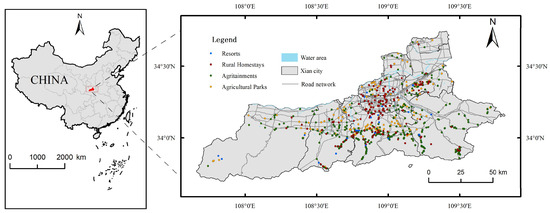
Figure 1
Open AccessArticle
Determinants of Simultaneous Use of Soil Fertility Information Sources among Smallholder Farmers in the Central Highlands of Kenya
by
, , , , and
Agriculture 2023, 13(9), 1729; https://doi.org/10.3390/agriculture13091729 (registering DOI) - 31 Aug 2023
Abstract
Soil fertility decline is a significant drawback to food and nutritional security in sub-Saharan Africa. However, information and knowledge barriers seriously impede the adoption, effective use, and scaling up of soil fertility management innovations, especially by smallholder farmers who produce the bulk of
[...] Read more.
Soil fertility decline is a significant drawback to food and nutritional security in sub-Saharan Africa. However, information and knowledge barriers seriously impede the adoption, effective use, and scaling up of soil fertility management innovations, especially by smallholder farmers who produce the bulk of the region’s food needs. Apart from the knowledge that smallholder farmers seek soil fertility information from diverse sources, which they apply simultaneously, there is limited knowledge of farmers’ information-seeking behaviour regarding which sources are used simultaneously and the factors influencing these choices. We employed a cross-sectional survey study design to determine the simultaneous use of soil fertility information sources of 400 smallholder farming households in the Central Highlands of Kenya. We analysed the data using descriptive statistics, principal component analysis (PCA), and a multivariate probit model. The PCA distinguished seven categories of information sources farmers use: local interpersonal, cosmopolite interpersonal, aggregative, print/demonstration, broadcast media, community-based, and progressive learning sources. The intensity of use revealed that most of the smallholders used soil fertility information sources simultaneously and primarily as complements. The determinants of simultaneous use of soil fertility information sources were farmer location, marital status, main occupation, age, farming experience, exposure to agricultural training, group membership, arable land and livestock units owned, soil fertility status, soil fertility change, and soil testing. This study’s findings have implications for information dissemination strategies involving using multiple complementary sources of knowledge for improved soil health and productivity.
Full article
(This article belongs to the Section Agricultural Economics, Policies and Rural Management)
►▼
Show Figures
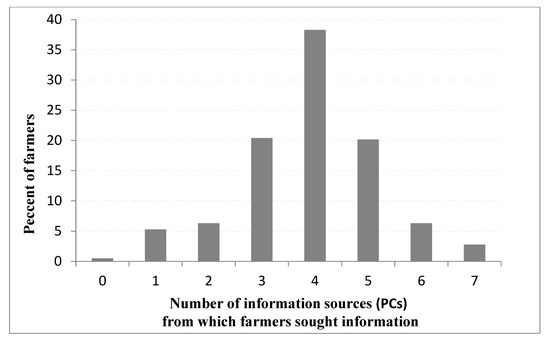
Figure 1
Open AccessArticle
Method of Attention-Based CNN for Weighing Pleurotus eryngii
Agriculture 2023, 13(9), 1728; https://doi.org/10.3390/agriculture13091728 - 31 Aug 2023
Abstract
Automatic weight detection is an essential step in the factory production of Pleurotus eryngii. In this study, a data set containing 1154 Pleurotus eryngii images was created, and then machine vision technology was used to extract eight two-dimensional features from the images.
[...] Read more.
Automatic weight detection is an essential step in the factory production of Pleurotus eryngii. In this study, a data set containing 1154 Pleurotus eryngii images was created, and then machine vision technology was used to extract eight two-dimensional features from the images. Because the fruiting bodies of Pleurotus eryngii have different shapes, these features were less correlated with weight. This paper proposed a multidimensional feature derivation method and an Attention-Based CNN model to solve this problem. This study aimed to realize the traditional feature screening task by deep learning algorithms and built an estimation model. Compared with different regression algorithms, the R2, RMSE, MAE, and MAPE of the Attention-Based CNN were 0.971, 7.77, 5.69, and 5.87%, respectively, and showed the best performance. Therefore, it can be used as an accurate, objective, and effective method for automatic weight measurements of Pleurotus eryngii.
Full article
(This article belongs to the Topic Applications of Big Data and Machine Learning in Smart Agriculture)
►▼
Show Figures
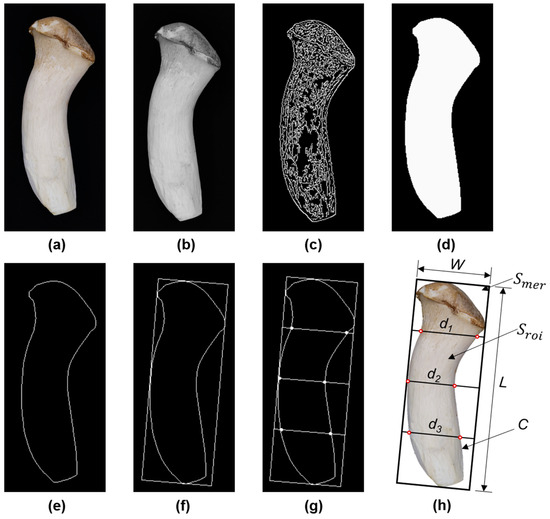
Figure 1
Open AccessArticle
Surveying North American Specialty Crop Growers’ Current Use of Soilless Substrates and Future Research and Education Needs
by
, , , , , , , and
Agriculture 2023, 13(9), 1727; https://doi.org/10.3390/agriculture13091727 - 31 Aug 2023
Abstract
Many specialty crop growers are transitioning high-value crops from in-ground production to soilless culture due to the diminishing availability of fumigants, increasing pest pressure, extreme weather, and the need for flexible production practices. The objective of this study was to determine the research
[...] Read more.
Many specialty crop growers are transitioning high-value crops from in-ground production to soilless culture due to the diminishing availability of fumigants, increasing pest pressure, extreme weather, and the need for flexible production practices. The objective of this study was to determine the research and educational needs of specialty crop growers who are transitioning to soilless substrates. North American growers were surveyed using an online instrument that incorporated Likert-type statement matrices, open-ended questions, and demographic questions. Additionally, two virtually led focus groups were conducted to further expand upon the quantitative findings with descriptive data. Respondents indicated the most important factors in considering whether to adopt soilless substrates were improving, managing, and reducing overall plant quality, disease management, and crop loss, respectively. The most important research needs were understanding the effects of substrates on crop quality and uniformity, fertilizer management, and economic costs and benefits/return on investment. In both the grower survey and focus groups, crop quality and uniformity were among the highest-scored responses. Food safety, disease and pest management, consumer perception, substrate disposal-related issues, transportation, and return-on-investment were also identified as important factors when considering soilless substrates.
Full article
(This article belongs to the Special Issue Advanced Research on Soilless Culture in Horticultural Production)
►▼
Show Figures
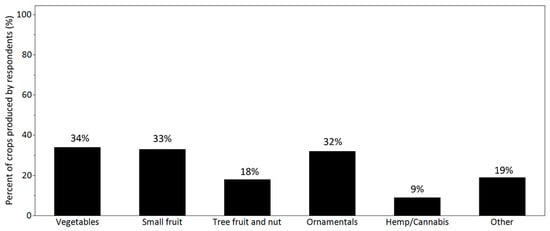
Figure 1
Open AccessArticle
Study on the Influence Mechanism of Energy Consumption of Sugarcane Harvester Extractor by Fluid Simulation and Experiment
Agriculture 2023, 13(9), 1726; https://doi.org/10.3390/agriculture13091726 - 31 Aug 2023
Abstract
Previous studies on sugarcane harvester extractors have mainly focused on improving harvest quality and reducing the impurity rate and loss rate, which often ignored the issue of high energy consumption. To reduce the energy consumption of the extractor while maintaining the original impurity
[...] Read more.
Previous studies on sugarcane harvester extractors have mainly focused on improving harvest quality and reducing the impurity rate and loss rate, which often ignored the issue of high energy consumption. To reduce the energy consumption of the extractor while maintaining the original impurity rate and loss rate stable, firstly, a blade element analysis method with aerodynamic theory was put forward to analyze the stress of the extractor blade, and the energy consumption equation and influencing factors of extraction were obtained. Subsequently, the computational fluid dynamics model of the exhaust extractor was established. Computational fluid dynamics (CFD) and the SST k-ω model were used to analyze the mechanism of various influencing factors on the energy consumption and internal flow characteristics of the extractor. The changes in various parameters were analyzed and discussed with respect to the resulting variations in internal pressure, velocity, vortex structure, and lift–drag coefficient of the extractor. A test bench of the extractor was built, and orthogonal tests were carried out with energy consumption, impurity rate, and loss rate as test indicators. Considering the results of the simulation and bench test comprehensively, the combination of a rotational speed of 1450 RPM, a blade number of 3, an installation angle of 25°, and a blade chord length of 200 mm was optimal for the extractor. Finally, a comparative test was carried out between the optimized extractor and the original extractor. The results demonstrated that the energy consumption of the optimized extractor was reduced by 15.49%. The impurity rate decreased by 3.51%, and the loss rate decreased by 12.39% compared to the original extractor. The study can provide a theoretical and experimental basis for designing and optimizing extractor performance.
Full article
(This article belongs to the Section Agricultural Technology)
►▼
Show Figures

Figure 1
Open AccessArticle
QTL Mining and Validation of Grain Nutritional Quality Characters in Rice (Oryza sativa L.) Using Two Introgression Line Populations
by
, , , , , , , , and
Agriculture 2023, 13(9), 1725; https://doi.org/10.3390/agriculture13091725 - 31 Aug 2023
Abstract
Nutritional grain quality is mainly influenced by the protein fraction content and grain protein content. Quantitative trait loci (QTL) mining for five traits, about 245 and 284 BC3F3 individual families of two introgression line (IL) populations were derived from Kongyu
[...] Read more.
Nutritional grain quality is mainly influenced by the protein fraction content and grain protein content. Quantitative trait loci (QTL) mining for five traits, about 245 and 284 BC3F3 individual families of two introgression line (IL) populations were derived from Kongyu 131/Cypress (population-I) and Kongyu 131/Vary Tarva Osla (population-II), respectively. A genetic linkage map was developed using 127 simple sequence repeat (SSR) markers in population-I and 119 SSR markers in population-II. In total, 20 and 5 QTLs were detected in population-I and population-II, respectively. About twenty QTLs were mapped in population-I: five QTLs for albumin, seven QTLs for globulin, six QTLs for prolamin, one QTL for glutelin, and one QTL for grain protein content. In total, five QTLs were mapped in population-II: one QTL for albumin and four QTLs for grain protein content. Out of 25 QTLs, 19 QTLs exhibit co-localization with the previously reported QTLs. QTL-like qGPC7.3 was delineated for total protein content. This QTL was derived from population-I and was successfully validated in NILs (near-isogenic lines). The grain protein phenotype showed a significant variation between two NILs. This investigation serves as groundwork for additional cloning of nutritional quality-related genes in rice grains.
Full article
(This article belongs to the Special Issue Breeding and Genetic Research of Cereal Grain Quality)
►▼
Show Figures
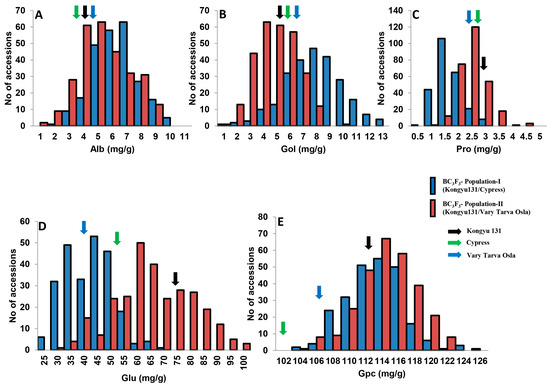
Figure 1
Open AccessReview
Progress and Prospective in the Development of Stored Grain Ecosystems in China: From Composition, Structure, and Smart Construction to Wisdom Methodology
Agriculture 2023, 13(9), 1724; https://doi.org/10.3390/agriculture13091724 - 31 Aug 2023
Abstract
Food security is intrinsically linked to maintaining optimal physical health and promoting active lifestyles. Stored Grain Ecosystems (SGEs) are complex systems comprising a range of grains, microorganisms, and environmental elements. To ensure sustainable grain storage and promote food-friendly SGEs, careful regulation and monitoring
[...] Read more.
Food security is intrinsically linked to maintaining optimal physical health and promoting active lifestyles. Stored Grain Ecosystems (SGEs) are complex systems comprising a range of grains, microorganisms, and environmental elements. To ensure sustainable grain storage and promote food-friendly SGEs, careful regulation and monitoring of these factors are vital. This review traces the evolution of the Eco-concept of stored grain in China, focusing on micro- and macro-structural composition, the Multi-field/Re-coupling structure, and Smart Construction of SGEs, while introducing the four development lines and Wisdom Methodology of SGEs. The current status and challenges of SGEs in China are also discussed. The Eco-concept of stored grain in China has progressed through the initial exploration period, formation and practice periods, and has now entered its fourth stage, marked by a shift to include interactions of multiple biological fields. This evolution extends beyond the traditional binary relationship and offers emerging technologies greater scope for scientific and intelligent theoretical analysis of grain storage practices. The Wisdom Methodology employs a multifaceted, Mechanism and Data-driven approach, incorporating four driving methods, and is now widely recognized as a leading strategy for researching Smart Grain Systems. Digital Twin technology enables precise simulations and mappings of real-world SGEs in a virtual environment, supporting accurate assessments and early warnings for issues concerning grain conditions. Driven by Mechanism and Data, Digital Twin solutions are a pioneering trend and emerging hotspot with vast potential for enhancing the intelligence and wisdom of future grain storage processes. Overall, this review provides valuable guidance to practitioners for advancing high-quality Smart Grain Systems, enhancing sustainable and intelligent grain storage practices.
Full article
(This article belongs to the Special Issue Grain Harvesting, Processing Technology, and Storage Management)
►▼
Show Figures
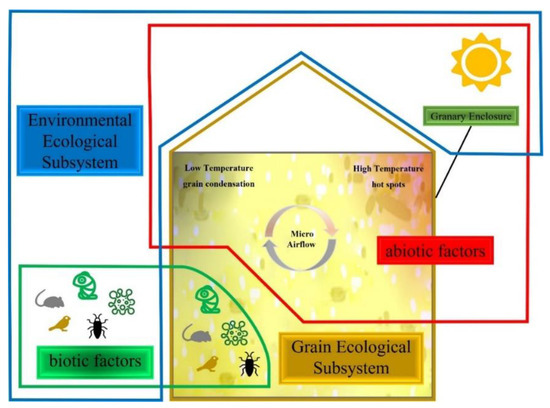
Figure 1
Open AccessArticle
The Impact of Environmental Regulation on Cultivated Land Use Eco-Efficiency: Evidence from China
Agriculture 2023, 13(9), 1723; https://doi.org/10.3390/agriculture13091723 - 30 Aug 2023
Abstract
In the context of tightening resource and environmental constraints, quantitative measurement and influencing factors of cultivated land use eco-efficiency (CLUE) have become hot topics in current academic research. Existing studies primarily focus on the influence of natural, social, and economic factors on CLUE
[...] Read more.
In the context of tightening resource and environmental constraints, quantitative measurement and influencing factors of cultivated land use eco-efficiency (CLUE) have become hot topics in current academic research. Existing studies primarily focus on the influence of natural, social, and economic factors on CLUE but ignore exploring the impact mechanism and effect of environmental policies on CLUE. Therefore, this study aims to explore the impact of environmental regulations on CLUE. To achieve this objective, a super-efficiency slack-based measure (super-SBM) model is used to calculate the CLUE for 31 provinces (municipalities and autonomous regions) in China from 2000 to 2009. Additionally, the intermediary effect model and the threshold effect model are used to empirically investigate the transmission mechanism and nonlinear characteristics between environmental regulation and the CLUE. The results show that: (1) the temporal dynamics of CLUE exhibit a pattern of initial fluctuating decline followed by gradual growth in China as a whole and across its eastern, central, and western regions. (2) Environmental regulation has a significant negative impact on CLUE, and the effect exhibits a nonlinear characteristic of decreasing marginal effects. (3) Agricultural technological innovation and agricultural industrial structure play a mediating role between environmental regulation and CLUE, reducing the negative impact of environmental regulation on CLUE. This study provides some implications for formulating scientifically sound environmental policies to optimize land use and enhance resource utilization efficiency.
Full article
(This article belongs to the Section Agricultural Economics, Policies and Rural Management)
Open AccessArticle
Land Use Suitability Model for Grapevine (Vitis vinifera L.) Cultivation Using the Best Worst Method: A Case Study from Ankara/Türkiye
Agriculture 2023, 13(9), 1722; https://doi.org/10.3390/agriculture13091722 - 30 Aug 2023
Abstract
The product of grapes with the highest added value is wine. Wine grapes play an important role in the evaluation of barren lands, where no other plants generally grow. Viticulture in Türkiye is generally conducted on small areas of agricultural land. In order
[...] Read more.
The product of grapes with the highest added value is wine. Wine grapes play an important role in the evaluation of barren lands, where no other plants generally grow. Viticulture in Türkiye is generally conducted on small areas of agricultural land. In order to develop viticulture, it is important to determine suitable areas. This study presents a model for assessing land suitability for cultivation of grapevines (Vitis vinifera L.) in the Ankara region (Türkiye). The aim is to provide a spatial decision support system based on geographic information system multi-criteria assessment, taking into account the perspectives of expert agricultural engineers and local product growers. In this study, 11 criteria were evaluated to determine the most suitable locations for grapevine cultivation. The best worst method was used to calculate the weights of the determined evaluation criteria. When the spatial distribution of the areas suitable for grapevine cultivation was examined from the resulting map produced, it was seen that 1879.29 km2 (7%) of highly suitability areas, 5062.03 km2 (20%) of medium suitability areas, 4706.20 km2 (18%) of low suitability areas, and 8355.36 km2 (33%) of unsuitable areas were detected. According to the results obtained, the southern parts of the study area are more suitable for grapevine cultivation. This study will be an important and useful regional guide for agricultural land use planning and the cultivation of grapevines.
Full article
(This article belongs to the Section Agricultural Systems and Management)
►▼
Show Figures
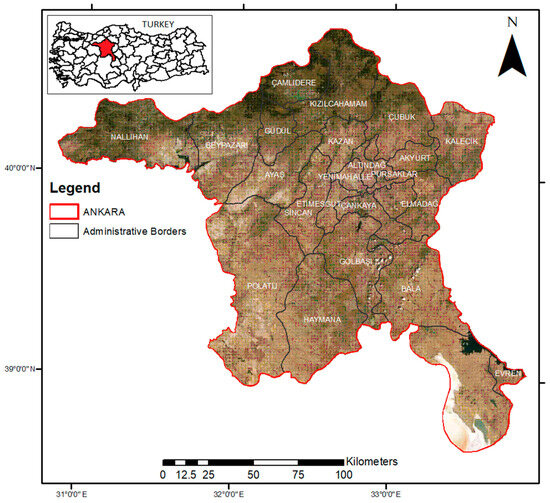
Figure 1
Open AccessReview
Genomic-Mediated Breeding Strategies for Global Warming in Chickpeas (Cicer arietinum L.)
by
, , , , , , , , , , , , , and
Agriculture 2023, 13(9), 1721; https://doi.org/10.3390/agriculture13091721 - 30 Aug 2023
Abstract
Although chickpea (Cicer arietinum L.) has high yield potential, its seed yield is often low and unstable due to the impact of abiotic stresses, such as drought and heat. As a result of global warming, both drought and heat are estimated to
[...] Read more.
Although chickpea (Cicer arietinum L.) has high yield potential, its seed yield is often low and unstable due to the impact of abiotic stresses, such as drought and heat. As a result of global warming, both drought and heat are estimated to be major yield constraints between one-quarter and one-third per annum. In the present review, genomic-mediated breeding strategies to increase resilience against global warming. Exacerbated drought and heat stresses have been examined to understand the latest advancement happening for better management of these challenges. Resistance mechanisms for drought and heat stresses consist of (i) escape via earliness, (ii) avoidance via morphological traits such as better root traits, compound leaves, or multipinnate leaves and double-/multiple-podded traits, and (iii) tolerance via molecular and physiological traits, such as special tissue and cellular abilities. Both stresses in chickpeas are quantitatively governed by minor genes and are profoundly influenced by edaphic and other environmental conditions. High-yield genotypes have traditionally been screened for resistance to drought and heat stresses in the target selection environment under stress conditions or in the simulacrum mediums under controlled conditions. There are many drought- and heat-tolerant genotypes among domestic and wild Cicer chickpeas, especially in accessions of C. reticulatum Ladiz., C. echinospermum P.H. Davis, and C. turcicum Toker, J. Berger, and Gokturk. The delineation of quantitative trait loci (QTLs) and genes allied to drought- and heat-related attributes have paved the way for designing stress-tolerant cultivars in chickpeas. Transgenic and “omics” technologies hold newer avenues for the basic understanding of background metabolic exchanges of QTLs/candidate genes for their further utilization. The overview of the effect of drought and heat stresses, its mechanisms/adaptive strategies, and markers linked to stress-related traits with their genetics and sources are pre-requisites for framing breeding programs of chickpeas with the intent of imparting drought tolerance. Ideotype chickpeas for resistance to drought and heat stresses were, therefore, developed directly using marker-aided selection over multiple locations. The current understanding of molecular breeding supported by functional genomics and omics technologies in developing drought- and heat-tolerant chickpea is discussed in this review.
Full article
(This article belongs to the Special Issue Genetic Diversity and Variability Assessment in Field Crops)
►▼
Show Figures
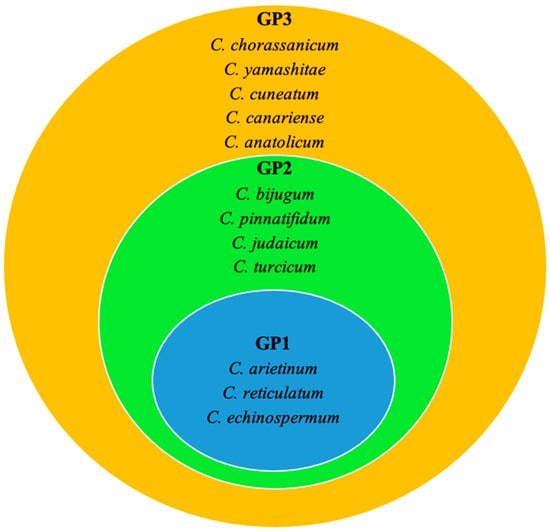
Figure 1
Open AccessArticle
Pruning Boosts Growth, Yield, and Fruit Quality of Old Valencia Orange Trees: A Field Study
by
, , , , , and
Agriculture 2023, 13(9), 1720; https://doi.org/10.3390/agriculture13091720 - 30 Aug 2023
Abstract
Pruning is an essential practice that helps control branch growth, optimize fruit size, and enhance fruit tree productivity. This study focused on ‘Valencia’ orange trees, which had experienced a decline in productivity after being cultivated on reclaimed lands for several years. The aim
[...] Read more.
Pruning is an essential practice that helps control branch growth, optimize fruit size, and enhance fruit tree productivity. This study focused on ‘Valencia’ orange trees, which had experienced a decline in productivity after being cultivated on reclaimed lands for several years. The aim was to explore the impact of pruning intensity on vegetation growth, fruit yield, productivity, and fruit quality in these orange trees. The study involved 35-year-old ‘Valencia’ orange trees, which were subjected to four different levels of pruning. The pruning treatments included: T1—no pruning (control group), T2—light pruning (removal of 25% of main branches), T3—moderate pruning (removal of 50% of main branches), and T4—heavy pruning (removal of 75% of main branches). Each season, these pruning measures were consistently carried out on 15 February. The results indicated that the severity of pruning directly influenced vegetative growth parameters, such as shoot length and leaf area. As the pruning intensity increased, so did the growth of the vegetation. However, the overall volume of the tree’s canopy decreased compared to the control group. These findings provide insights into the relationship between pruning practices and the growth and productivity of ‘Valencia’ orange trees. The highest fruit yields were observed when pruning was carried out at a severity level of 75%, followed by 50 and 25%. These pruning treatments had a positive impact on various aspects of fruit quality, including weight, size, firmness, juice content, TSS (°Brix), TSS/acid ratio, and vitamin C content. Additionally, pruning contributed to a greater fruit yield per tree and an overall increase in the yield percentage. In essence, the findings suggest that pruning performed at different severity levels in February effectively promotes vegetation growth and enhances the physical and chemical properties of ‘Valencia’ orange trees. Notably, it resulted in a nearly 20% rise in fruit yield compared to the control group.
Full article
(This article belongs to the Special Issue Agrotechnology of Improving Yield and Quality in Field Crops under Climate Change)
►▼
Show Figures
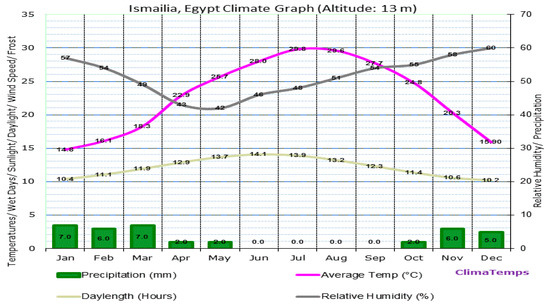
Figure 1
Open AccessArticle
Allelopathic Effects of Caffeic Acid and Its Derivatives on Seed Germination and Growth Competitiveness of Native Plants (Lantana indica) and Invasive Plants (Solidago canadensis)
by
, , , , , , and
Agriculture 2023, 13(9), 1719; https://doi.org/10.3390/agriculture13091719 - 30 Aug 2023
Abstract
Allelopathy has garnered considerable attention, but the effects of different allelochemicals on invasive plants remain unclear. This study addressed the knowledge gap surrounding allelopathy and its impact on native and invasive plant species. We focused on the impact of caffeic acid and its
[...] Read more.
Allelopathy has garnered considerable attention, but the effects of different allelochemicals on invasive plants remain unclear. This study addressed the knowledge gap surrounding allelopathy and its impact on native and invasive plant species. We focused on the impact of caffeic acid and its derivatives on the growth and competitiveness of the native Lantana indica and the invasive plant Solidago canadensis. We selected three allelochemicals, caffeic acid, methyl caffeic acid, and ethyl caffeic acid, for evaluation at two concentrations (0.1 mM and 1.0 mM). Three planting methods were employed: (1) a single species of S. canadensis, (2) a single species of L. indica, and (3) a combination of S. canadensis and L. indica. In addition, a control group was also included. Results revealed that high concentrations (1 mM) of methyl caffeate (MC) and ethyl caffeate (EC) significantly reduced seed germination rate, seed germination index, and seed germination speed index of L. indica compared to a low concentration (0.1 mM). Plant height, stem diameter, biomass, and root length in the control group (CK) of S. canadensis were significantly higher than those in the treated groups. However, with increasing allelochemical concentration, L. indica’s relative competitiveness gradually decreased. These findings provide insights into the concentration-dependent effects of allelopathic compounds on the growth of L. indica and S. canadensis. By analyzing how these allelochemicals influence the growth and competitiveness of native and invasive plants, the study sheds light on the dynamics of allelochemical interactions between these species. This knowledge can be pivotal for understanding plant competition dynamics in ecosystems and could inform strategies to control invasive species or promote native plant growth.
Full article
(This article belongs to the Special Issue Effects of Invasive Plants on Soil)
►▼
Show Figures
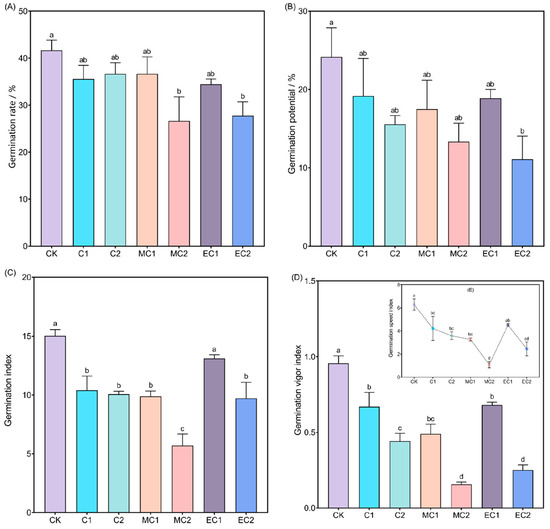
Figure 1
Open AccessArticle
A Large Benchmark Dataset for Individual Sheep Face Recognition
Agriculture 2023, 13(9), 1718; https://doi.org/10.3390/agriculture13091718 - 30 Aug 2023
Abstract
The mutton sheep breeding industry has transformed significantly in recent years, from traditional grassland free-range farming to a more intelligent approach. As a result, automated sheep face recognition systems have become vital to modern breeding practices and have gradually replaced ear tagging and
[...] Read more.
The mutton sheep breeding industry has transformed significantly in recent years, from traditional grassland free-range farming to a more intelligent approach. As a result, automated sheep face recognition systems have become vital to modern breeding practices and have gradually replaced ear tagging and other manual tracking techniques. Although sheep face datasets have been introduced in previous studies, they have often involved pose or background restrictions (e.g., fixing of the subject’s head, cleaning of the face), which restrict data collection and have limited the size of available sample sets. As a result, a comprehensive benchmark designed exclusively for the evaluation of individual sheep recognition algorithms is lacking. To address this issue, this study developed a large-scale benchmark dataset, Sheepface-107, comprising 5350 images acquired from 107 different subjects. Images were collected from each sheep at multiple angles, including front and back views, in a diverse collection that provides a more comprehensive representation of facial features. In addition to the dataset, an assessment protocol was developed by applying multiple evaluation metrics to the results produced by three different deep learning models: VGG16, GoogLeNet, and ResNet50, which achieved F1-scores of 83.79%, 89.11%, and 93.44%, respectively. A statistical analysis of each algorithm suggested that accuracy and the number of parameters were the most informative metrics for use in evaluating recognition performance.
Full article
(This article belongs to the Section Digital Agriculture)
►▼
Show Figures
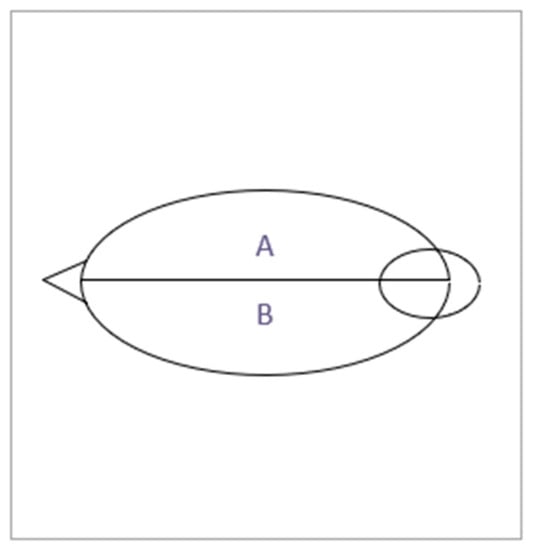
Figure 1
Open AccessArticle
Effects of the Dietary Replacement of Soybean Oil with Rubber Seed Oil on the Growth Performance, Carcass Trait, and Status of Lipid Metabolism in Pekin Ducks
by
, , , , , , and
Agriculture 2023, 13(9), 1717; https://doi.org/10.3390/agriculture13091717 - 30 Aug 2023
Abstract
The objective of this study is to determine the effects of the dietary replacement of soybean oil (SO) with rubber seed oil (RSO) on the growth performance, carcass trait, and lipid metabolism in Pekin ducks. A total of 160 1-day-old Pekin ducks were
[...] Read more.
The objective of this study is to determine the effects of the dietary replacement of soybean oil (SO) with rubber seed oil (RSO) on the growth performance, carcass trait, and lipid metabolism in Pekin ducks. A total of 160 1-day-old Pekin ducks were randomly allocated to four experimental treatments and fed diets with different ratios of SO to RSO as follows: 3:0 (control), 2:1, 1:2, and 0:3. Dietary RSO supplementation had no effect on their growth performance; however, it significantly decreased the yield of abdominal fat (p < 0.05). As the dietary RSO increased, the plasma TG, CHO, LDL-C, and HDL-C contents of ducks decreased (p < 0.05). Additionally, the contents of total fat, triglycerides, and cholesterol in the liver and breast reduced in the ducks fed RSO diets (p < 0.05). Liver n-3 PUFA levels linearly increased (p < 0.05), while the n-6/n-3 PUFA ratios reduced with increasing RSO levels (p < 0.05). Moreover, dietary RSO supplementation resulted in decreased gene expressions of FABP1, ME1, SREBP1c, FASN, DGAT2, and HMGCR (p < 0.05), while there was an increased expression of the ABCA1 gene (p < 0.05) in the liver of the ducks. In conclusion, dietary RSO supplementation reduced fat deposition and enhanced n-3 PUFA levels without affecting the growth performance of Pekin ducks.
Full article
(This article belongs to the Special Issue Animal Nutrition and Productions: Series II)
►▼
Show Figures
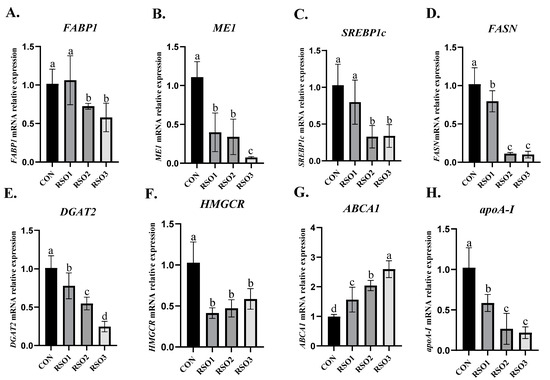
Figure 1
Open AccessReview
Positioning Portugal in the Context of World Almond Production and Research
by
, , , , , , and
Agriculture 2023, 13(9), 1716; https://doi.org/10.3390/agriculture13091716 - 30 Aug 2023
Abstract
Almond production plays a very significant role in the Portuguese socio-economic context, especially with regard to dried fruit production. Indeed, Portugal is the third largest almond producer in Europe, producing 41,450 t of almonds in shells in 2021. This is due to its
[...] Read more.
Almond production plays a very significant role in the Portuguese socio-economic context, especially with regard to dried fruit production. Indeed, Portugal is the third largest almond producer in Europe, producing 41,450 t of almonds in shells in 2021. This is due to its edaphoclimatic conditions that are favorable for its production. Traditionally, the north region of “Trás-os-Montes” has stood out as one of the most relevant for Portuguese almond production and bioeconomy. However, production in “Alentejo“ and “Beira Interior” will surpass the northern region in a short time as a result of the installation of new orchards. Despite its importance, there is a need to uncover genetic traits underlying phenotypic desirable traits needed to improve yield and quality but also cope and mitigate the impacts of climate change on their production. To address this, it is important to characterize the genetic resources available and the germplasm collection since they are crucial players for conservation and breeding initiatives. In this review, we describe the main cultivars of almonds cultivated in Portugal and their productive challenges. We also provide an overview of the main genetic resources available, breeding goals, and accomplishments regarding their improvement towards biotic and abiotic constraints in both Portugal and the rest of the world.
Full article
(This article belongs to the Special Issue Fruit Breeding, Germplasms Identification and Evaluation)
►▼
Show Figures
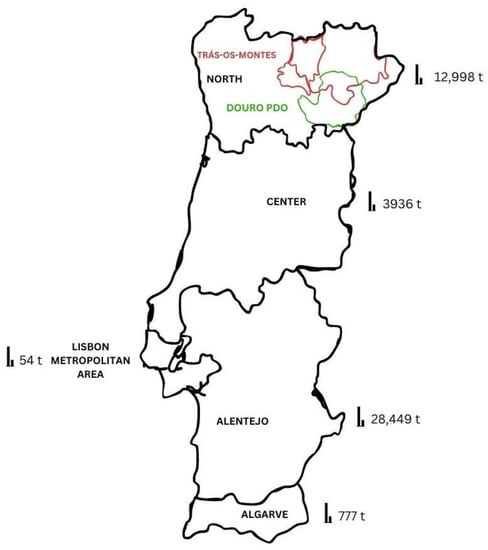
Figure 1

Journal Menu
► ▼ Journal Menu-
- Agriculture Home
- Aims & Scope
- Editorial Board
- Reviewer Board
- Topical Advisory Panel
- Instructions for Authors
- Special Issues
- Topics
- Sections
- Article Processing Charge
- Indexing & Archiving
- Editor’s Choice Articles
- Most Cited & Viewed
- Journal Statistics
- Journal History
- Journal Awards
- Conferences
- Editorial Office
Journal Browser
► ▼ Journal BrowserHighly Accessed Articles
Latest Books
E-Mail Alert
News
Topics
Topic in
Agriculture, Energies, Foods, Sustainability
New Insights in Agriculture: Sustainability, Digitalization and Food Safety
Topic Editors: Kristina Kljak, Klaudija Carović-Stanko, Darija Lemić, Jernej Jakše, Kurt A. Rosentrater, Arup Kumar Goswami, Craig SturrockDeadline: 15 September 2023
Topic in
Agriculture, Agronomy, Drones, Horticulturae, Remote Sensing, Sensors
Applications of Big Data and Machine Learning in Smart Agriculture
Topic Editors: Xiuliang Jin, Hao Yang, Zhenhai Li, Changping Huang, Dameng YinDeadline: 30 September 2023
Topic in
Agriculture, Agronomy, Crops, Plants, Viruses
Plant Virus
Topic Editors: Munir Mawassi, Sergey MorozovDeadline: 31 October 2023
Topic in
Agriculture, Agronomy, Crops, JoF, Plants
Interaction between Plants and Fungi and Oomycetes
Topic Editors: Ana P. G. C. Marques, Nadia Massa, Santa Olga CacciolaDeadline: 30 November 2023

Conferences
Special Issues
Special Issue in
Agriculture
Innovative Approaches for Sustainable Management of Agricultural Water Resources
Guest Editors: Pete Jacoby, Sayed Hossein SadeghiDeadline: 5 September 2023
Special Issue in
Agriculture
Effect of Preharvest and Postharvest Technologies on Fruit Ripening and Senescence
Guest Editors: Maria Jose Gimenez Torres, María E. García-PastorDeadline: 20 September 2023
Special Issue in
Agriculture
Natural Resource and Environmental Economics in Agriculture
Guest Editor: Edward OseiDeadline: 30 September 2023
Special Issue in
Agriculture
Integrated Management of Soil-Borne Diseases
Guest Editors: Dongdong Yan, Wensheng Fang, Aocheng CaoDeadline: 15 October 2023


















